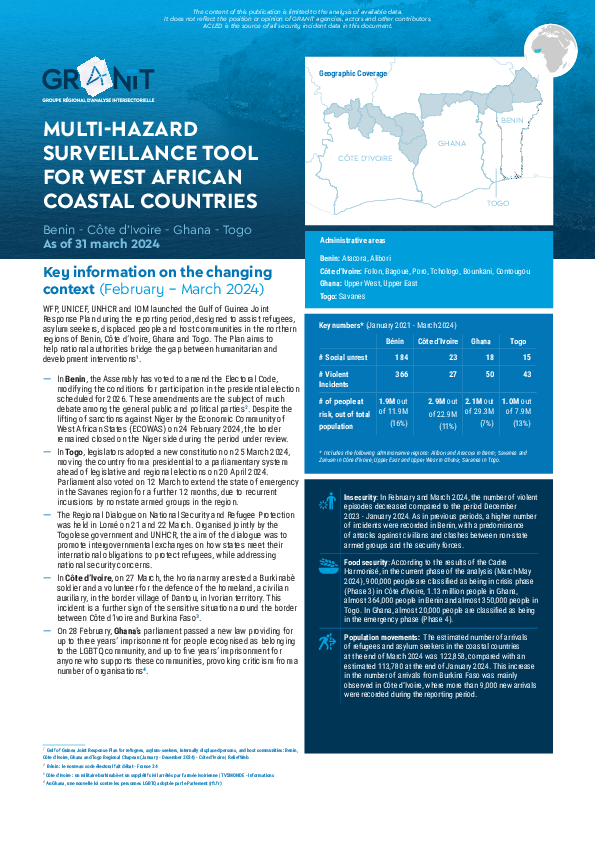-
Countries
-
Data and Analysis
-
Special Focus
-
Crisis Responses
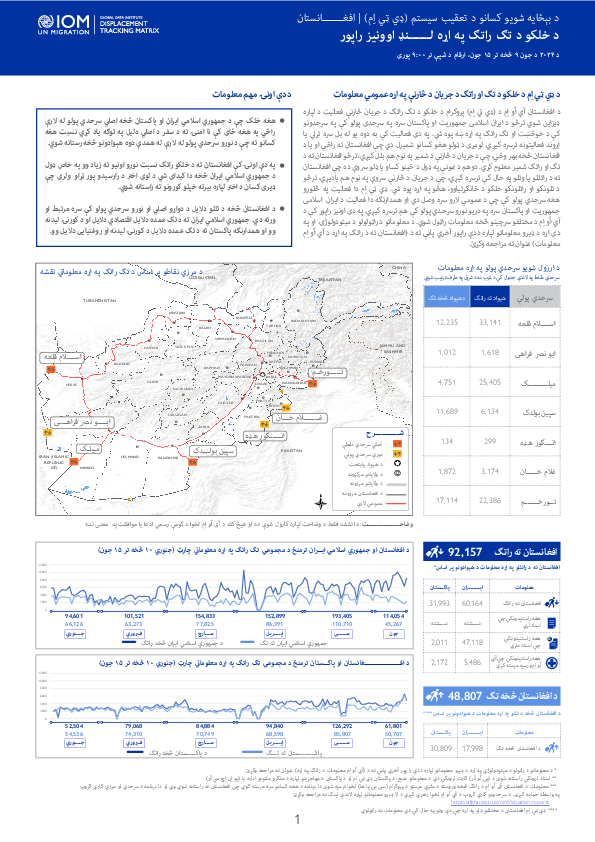
Contact
DTMAfghanistan@iom.int
Language
Pashto
Location
Afghanistan
Period Covered
Jun 09 2024
Jun 15 2024
Activity
- Survey
- Flow Monitoring Survey
- Flow Monitoring
د افغانستان آي اُو اِم د (ډي تي اِم) پروګرام د خلکو د تګ راتګ د جریان څارنې فعالیت د لپاره ډیزاین شوي ترڅو د ایران اسلامی جمهوریت او پاکستان سره په سرحدی پولو کې په سرحدونو کې د خوځښت او تګ راتګ په اړه ښه پوه شي. په دی فعالیت کې به دوه یو له بل سره تړلي یا اړوند فعالیتونه ترسره کیږي. لومړی د ټولو هغو کسانو شمیرل دي چې افغانستان ته راځي او یا د افغانستان څخه بهر وځي، چې د جریان د څارنې د شمیر په نوم هم بلل کیږي، ترڅو افغانستان ته د تګ او راتګ شمیر معلوم کړي. دوهم د نمونې په ډول د ځینو کساو یا ډلو سروې ده چې افغانستان ته د راتللو یا وتلو په حال کې ترسره کیږي، چې د جریان د څارنې سروې په نوم هم یادیږي، ترڅو د تلونکو او راتلونکو خلکو د ځانګړتیاوو، هڅو په اړه پوه شي. ډي ټي اِم دا فعالیت په څلورو هغه سرحدي پولو کې چې د عمومي لارو سره وصل دي او همدارنګه دا فعالیت د ایران اسلامی جمهوریت او پاکستان سره په دریو نورو سرحدي پولو کې هم ترسره کیږي. په دی اونیز راپور کې د آي اُو اِم د مختلفو سرچینو څخه معلومات راټول شوي. د معلوماتو د راټولولو د میتودولوژۍ او په دی اړه د ډیرو معلوماتو لپاره ددې راپور آخري پاڼې ته د (افغانستان ته د راتګ په اړه د آي اُو اِم معلومات) عنوان ته مراجعه وکړئ

Contact
DTMAfghanistan@iom.int
Language
English
Location
Afghanistan
Period Covered
Jun 09 2024
Jun 15 2024
Activity
- Survey
- Flow Monitoring Survey
- Flow Monitoring
The IOM Afghanistan’s DTM Flow Monitoring activity is designed to provide insights into the mobility patterns at Afghanistan’s border points with the Islamic Republic of Iran and Pakistan. The activity involves two interlinked exercises: the Flow Monitoring Counting (FMC), a headcount of individuals crossing the border, and the Flow Monitoring Surveys (FMS), which collect data on the profiles and intentions of randomly selected Afghan nationals. DTM FM is operational at four main crossing points (connected to Afghanistan’s National Highway) as well as three other crossing points with Islamic Republic of Iran and Pakistan. This weekly snapshot combines information from the FM activity and various IOM sources related to cross-border movement. For a detailed explanation of the methodology used in gathering this data, the report directs readers to the section titled “IOM INFLOW DATA” on the last page.
The GRANIT was conceived in 2021 in Dakar at the initiative of OCHA, IOM and REACH with the support of the Regional Sectoral Groups, UN agencies and NGOs. GRANIT seeks to create a forum of technical experts and information managers to pave the way for a regional, holistic and cross-sectoral analytical approach to inform the crisis preparedness and response phases. The aim of the monitoring tool is to track developments in the context in the target countries, using a multi-hazard approach. To this end, 15 indicators have been selected by the regional group of experts in emergency preparedness and response and GRANIT members. This report presents the evolution of the situation in Benin, Côte d'Ivoire, Ghana and Togo, as of 31 March 2024.
This document is a compilation of data collected by IOM from FRONTEX as well as the Italian, Spanish, Greek, and Maltese interior ministries on migratory movements from Africa to Europe between 2017 and 2023. IOM works closely with a wide range of actors, including government and non-government partners, to collect and compile this data every quarter. This document presents the situation of migrant arrivals in Europe based on data between 2017 and 2023 from the point of view of movements from West and Central Africa (WCA).
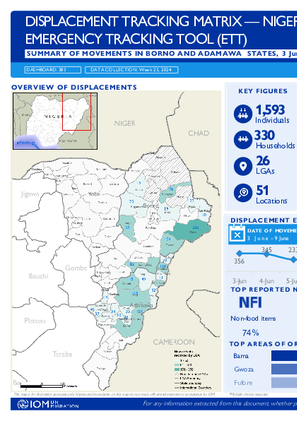
Contact
iomnigeriadtm@iom.int
Language
English
Location
Nigeria
Period Covered
Jun 03 2024
Jun 09 2024
Activity
- Registration
- Rapid Emergency Registration
- Mobility Tracking
Between 3 June and 9 June 2024, a total of 1,593 new arrivals were recorded at locations in Adamawa and Borno states. The new arrivals were recorded at locations in Askira/Uba, Bama, Gubio, Gwoza, Kaga, Kala Balge, Mafa, Magumeri, Monguno and Ngala Local Government Areas (LGAs) of the most conflict-affected Borno State and in Demsa, Fufore, Girei, Gombi, Guyuk, Hong, Lamurde, Madagali, Maiha, Michika, Mubi North, Mubi South, Numan, Song, Yola North and Yola South LGAs of Adamawa State.
ETT assessments identified the following movement triggers: military operations (358 individuals or 22%), poor living conditions (349 individuals or 22%), seasonal farming (318 individuals or 20%), improved security (191 individuals or 12%), family re-unification (131 individuals or 8%), fear of attack (119 individuals or 8%), access to humanitarian support (67 individuals or 4%) and attack (60 individuals or 4%).

Contact
DTM Ethiopia, DTMEthiopia@iom.int
Language
English
Location
Ethiopia
Period Covered
Apr 01 2024
Apr 30 2024
Activity
- Flow Monitoring
In April 2024, a total of 35,086 movements were observed across the six flow monitoring points (FMPs) in Ethiopia. This represents a 16% decrease in daily average movements in comparison with March 2024 when an average of 1,395 movements per day were observed.
The ratio between outgoing movements (67% or 23,666 individuals) during April and incoming movements (33% or 11,420 individuals) slightly changed, as the incoming movements decreased compared to the March incoming movements. In March 2024, 10,961 incoming individuals were recorded traveling from Kenya, whereas only 1,589 incoming individuals from Kenya were observed in April. Historically, recorded outflows have been higher than inflows as seen in the figure below. However, in May and June 2023, due to the outbreak of the Sudan crisis, inflows exceeded outflows.
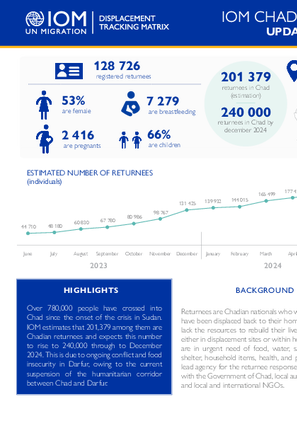
Contact
DTM Chad, dtmtchad@iom.int
Language
English
Location
Chad
Period Covered
Jun 18 2024
Jun 18 2024
Activity
- Mobility Tracking
- Event Tracking
Over 780,000 people have crossed into Chad since the onset of the crisis in Sudan. IOM estimates that 201,379 among them are Chadian returnees and expects this number to rise to 240,000 through to December 2024. This is due to ongoing conflict and food insecurity in Darfur, owing to the current suspension of the humanitarian corridor between Chad and Darfur.
Returnees are Chadian nationals who were living in Sudan and have been displaced back to their home country where they lack the resources to rebuild their lives. Returnees are living either in displacement sites or within host communities. They are in urgent need of food, water, sanitation and hygiene shelter, household items, health, and protection. IOM is the lead agency for the returnee response, in close coordination with the Government of Chad, local authorities, UN agencies, and local and international NGOs.
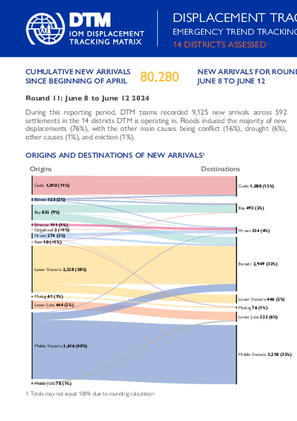
Contact
DTM Somalia, IOMSomaliaDTM@iom.int
Language
English
Location
Somalia
Period Covered
Jun 08 2024
Jun 12 2024
Activity
- Mobility Tracking
- Baseline Assessment
This latest round of Emergency Trends Tracking was initiated in April 2024 to monitor displacements movements during the Gu rainy season. Districts covered in this round include Afgooye, Afmadow, Baardheere, Baidoa, Balcad, Belet Weyne, Dayniile, Gaalkacyo, Hodan, Jamaame, Jowhar, Kahda, Kismaayo, Luuq. ETT is a crisis-based tool that tracks sudden displacement triggered by specific events or emerging crises.
The objective of ETT is to help prioritize humanitarian response and to enable partners to deliver rapid assistance. Based on previous shock induced displacement patterns, the humanitarian community expects that people will continue to move toward urban areas in search of humanitarian services. Consequently, the ETT coverage focuses on the main urban centers and surrounding villages for each assessed district. The data is collected through Key Informant Interviews (KIIs) at the location level, from Sunday to Wednesday every week. It includes information on new arrivals, numbers and demographic of IDPs, reasons for displacement, intentions, humanitarian assistance and priority needs among others.
The ETT tool also adapts to regional contexts: because of the very high number of IDP sites in Khada and Daynile districts in Banadir region and in Baidoa district in Bay region, a zonal approach has been adopted for these areas. Each week, KIIs are first conducted at the zone level to indicate to the field teams which locations have received the most new arrivals and which need to be assessed. To facilitate the joint analysis of the CCCM (Camp Coordination and Camp Management) Cluster’s New Arrivals Tracker (NAT) and ETT data, the assistance and needs indicators are identical in both tools.
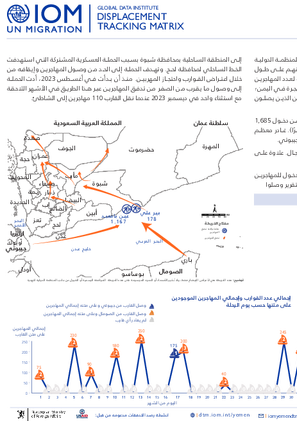
Contact
DTM Yemen, DTMYemen@iom.int
Language
English
Location
Yemen
Period Covered
May 01 2024
May 31 2024
Activity
- Flow Monitoring
في مايو 2024، أبلغت مصفوفة تتبع النزوح في اليمن التابعة للمنظمة الدولية للهجرة عن دخول 1,685 مهاجرًا إلى اليمن، بزيادة قدرها 14 بالمائة عن الرقم الإجمالي المُبلغ عنه في الشهر السابق (1,479 مهاجرًا). غادر معظم المهاجرين (90%) من منطقة باري في الصومال (1,510)، في حين غادر العشرة في المائة المتبقية من أوبوك، جيبوتي.
ومن بين إجمالي المهاجرين المسجلين، كان 13 في المائة أطفال، و26 في المائة نساء، و62 في المائة رجال). علاوة على ذلك، ذكر 80 في المائة من المهاجرين أن النزاع كان السبب الرئيسي الذي دفعهم إلى مغادرة بلدهم الأصلي.
وعادةً ما تكون لحج بمثابة نقطة دخول للمهاجرين المغادرين عبر جيبوتي، في حين تعد شبوة بمثابة نقطة دخول للمهاجرين المغادرين عبر الصومال. ومع ذلك، فإن جميع المهاجرين الذين غادروا جيبوتي والصومال في الفترة المشمولة بالتقرير وصلوا إلى المنطقة الساحلية بمحافظة شبوة بسبب الحملة العسكرية المشتركة التي استهدفت الخط الساحلي لمحافظة لحج. وتهدف الحملة إلى الحد من وصول المهاجرين وإيقافه من خلال اعتراض القوارب واحتجاز المهربين. منذ أن بدأت في أغسطس 2023، أدت الحملة إلى وصول ما يقرب من الصفر من تدفق المهاجرين عبر هذا الطريق في الأشهر اللاحقة مع استثناء واحد في ديسمبر 2023 عندما نقل القارب 110 مهاجرين إلى الشاطئ.
حدد فريق مصفوفة تتبع النزوح 4,010 عائدًا يمنيًا في مايو 2024، وهو ما يمثل انخفاضًا بنسبة 21 بالمائة مقارنة بعدد العائدين في أبريل (5,046 فردًا). بالإضافة إلى ذلك، سجل الفريق ما مجموعه 221 مهاجرًا تم ترحيلهم من عمان إلى نقطة ديفن في مديرية شحن بمحافظة المهرة باليمن. وكان جميع المهاجرين المرحلين من عمان مواطنين إثيوبيين.
أجبرت الأزمة الإنسانية المتفاقمة في اليمن العديد من المهاجرين على اتخاذ قرار صعب بالعودة إلى بلدانهم الأصلية في القرن الأفريقي، حيث أفادت التقارير أن السلطات قامت بترحيل بعضهم. في مايو 2024، سجلت مصفوفة تتبع النزوح ما مجموعه 750 مهاجرًا غادروا اليمن إما طوعًا أو تم ترحيلهم بالقوارب من اليمن. وتتكون هذه المجموعة من 90% رجال، و9% نساء، و1% أطفال.
علاوة على ذلك، في مايو 2024، أبلغ فريق مصفوفة تتبع النزوح في جيبوتي عن وصول إجمالي 1,240 مهاجرًا (91% رجال، و8% نساء، و1% أطفال) إلى جيبوتي قادمين من اليمن بعد القيام برحلة محفوفة بالمخاطر للعودة إلى وطنهم. وتؤكد هذه الأرقام التحديات الكبيرة التي يواجهها المهاجرون في اليمن والظروف اليائسة التي دفعتهم إلى المخاطرة برحلات بحرية خطيرة.
Contact
iomyemendtm@iom.int
Location
Yemen
Activity
- Flow Monitoring
Period Covered
May 01 2024 -May 31 2024
In May 2024, the IOM Yemen DTM reported 1,685 migrants entering Yemen, a 14 per cent increase from the total figure reported in the previous month (1,479 migrants). Most migrants (90%) left from Bari Region in Somalia (1,510), while the remaining ten per cent left from Obock, Djibouti.
Among the total migrants recorded, 13 per cent were children, 26 per cent were women, and 62 per cent were men). Furthermore, 80 per cent of migrants stated that conflict was the primary reason encourage them for leaving their country of origin.
Typically, Lahj serves as an entry point for migrants departing through Djibouti whereas Shabwah serves as an entry point for migrants departing through Somalia. However, all migrants departed from Djibouti and Somalia in this reporting period arrived in coastal area of Shabwah Governorate due joint military campaign targeting the coastline of Lahj Governorate. The campaign aiming at reducing and stopping the arrival of migrants by intercepting boats and detaining smugglers. Since it started in August 2023, the campaign resulted a near-zero arrival of migrant flow through this route in the subsequent months with a single exception in December 2023 when boat transported 110 migrants ashore.
The DTM team identified 4,010 Yemeni returnees in May 2024, a 21 per cent decrease compared to the number of returnees in April (5,046 individuals). Additionally, the team recorded a total of 221 migrants that were deported from Oman back to Deifen Point in Shahan district of Al Maharah governorate, Yemen. All deported migrants from Oman were Ethiopian nationals.
The worsening humanitarian crisis in Yemen has compelled many migrants to make difficult decision to return to their home countries in the Horn of Africa, some have reportedly been deported by authorities. In May 2024, the DTM recorded a total of 750 migrants leaving Yemen either voluntarily or were deported by boat from Yemen. This group was composed of 90 per cent men, nine per cent women, and one per cent children.
Furthermore, in May 2024, the Djibouti DTM team reported a total of 1,240 migrants (91% men, 8% women, and 1% children) arrived in Djibouti from Yemen after undertaking a perilous journey back home. These figures underscore the significant challenges migrants in Yemen face and the desperate circumstances that have led them to risk dangerous sea voyages.
Population Groups
Migrants Present
Survey Methodology
Unit of Analysis Or Observation
Admin Area 2
Individual
Type of Survey or Assessment
Key Informant
Keywords
Geographical Scope Partial Coverage
Administrative boundaries with available data
The current dataset covers the following administrative boundaries
